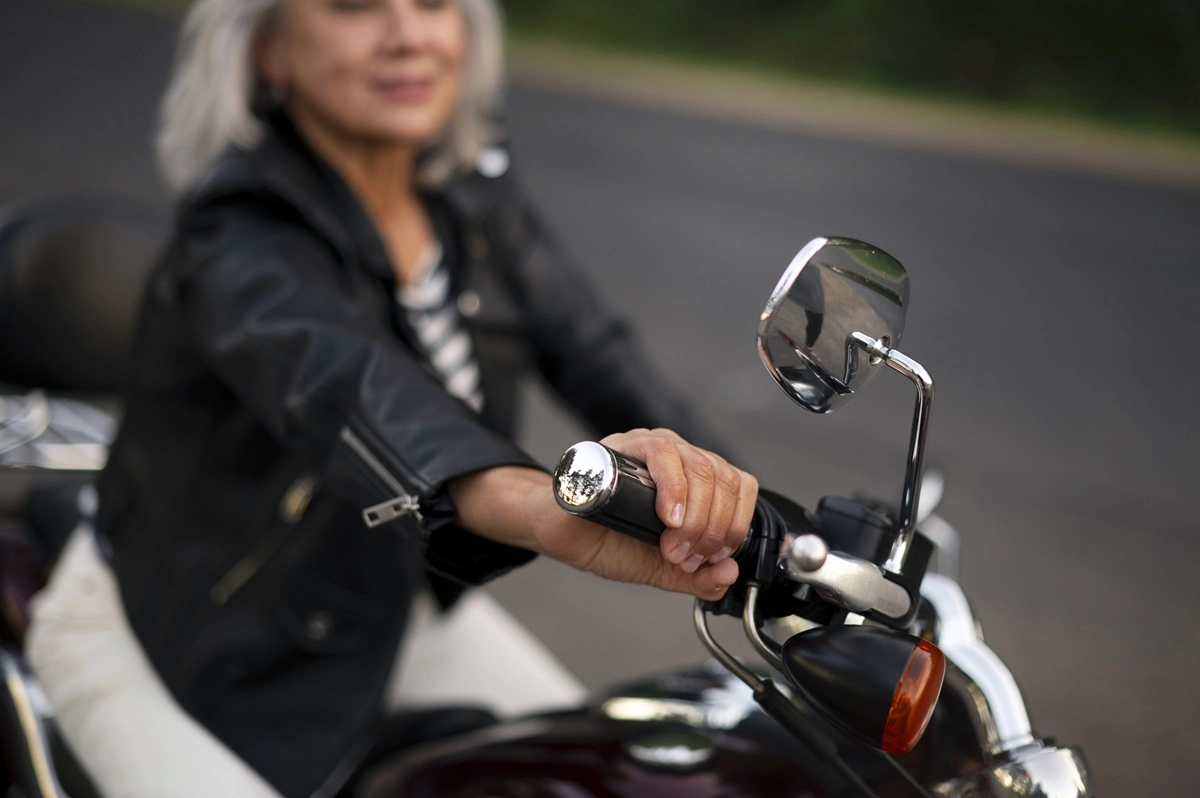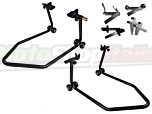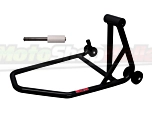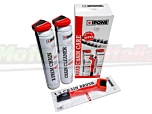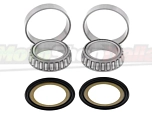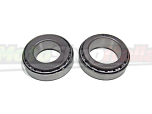Maneuverability of your motorcycle? Well, it's not magic, but something much more accessible: it's literally in your hands. Let's start with a simple but often forgotten truth: your two-wheeler has a soul that responds to your touch, your movements, your attention.
Let's begin with a basic concept: do you really know your motorcycle? Each model has its personality, its secrets, its habits. Familiarizing yourself with these characteristics will allow you to understand how it reacts in different situations. You don't need a degree in mechanical engineering, but flipping through the instruction manual might prove more useful than you think.
Then there's maintenance, that routine that might seem tedious but is actually your ticket to smooth and safe riding. Tires, brakes, chain: these are your best allies on the road. Treat them well, and they will take you far, literally.
And posture? Ah, posture is everything. A good position in the saddle makes the difference between driving and "flying" on the road. Relaxed but always ready, that's how your body should be. It's a bit like dancing, in harmony with your motorcycle, anticipating the curves and balancing the weight naturally.
Finally, but not least, experience. It can't be bought online, it can't be downloaded, it's built mile after mile. Every outing is an opportunity to learn, to refine those techniques that transform ordinary driving into an extraordinary experience. Practice, as they say, is the mother of all skills.
So, improving your motorcycle's maneuverability is a journey that starts with small steps: knowledge, maintenance, posture, experience. You don't need to be born with a helmet on your head to fully enjoy this journey. Just want it, and the road will open up before you, curves included.
Best Tips to Improve Motorcycle Maneuverability
Check and consider replacing your motorcycle's tires
The tires under your motorcycle? They're everything. Imagine wearing sneakers for an ice marathon. Wrong, right? Well, the same logic applies to your two-wheeler. The right choice of tires transforms the ride, making it safer, smoother, more your own.
Let's start from the basics: every tire tells a story, that of your riding style and the roads you prefer. Are you more into smooth asphalt or dirt paths? The answer to this question guides you towards the type of tire that's right for you. Touring, sport, off-road: each category has its peculiarities, designed to best adapt to every surface.
Size plays a leading role. Altering the sizes recommended by your motorcycle's manufacturer is like wearing shoes that are too tight or too loose: uncomfortable and, frankly, dangerous. Respect the guidelines to maintain the motorcycle's geometry in balance, thus ensuring stable and responsive riding.
Don't underestimate the pressure. Too low? The motorcycle drags, consumes more, tire wear accelerates. Too high? You lose grip, and with it, safety. A regular check, maybe every two weeks, keeps you away from these issues. And remember, temperature variations affect pressure: a glance at the thermometer doesn't hurt.
Understanding when it's time to say goodbye to your tires is an art. Wear, age, cracks: these are all signs that should not be ignored. An old or worn tire not only compromises maneuverability but can become a serious risk to your safety.
In short, tires are your first line of defense on the road. Choosing them well, keeping them in shape, and knowing when to let them go makes a difference. Not just in driving but in your overall experience in the saddle. The road calls, make sure your tires are ready to answer.
Tire sizes and pressure: their impact on riding
When we talk about tire sizes and pressure, we're touching the heart of two-wheel driving. Imagine tires as the foundation of a house: if they're not solid and suitable, everything else wobbles. That's why it's crucial not just to choose them well but also to keep them in optimal condition.
The right tire sizes are the key to a ride that is both smooth and safe. The motorcycle was designed to be at its best with those measurements, not others. Deviating from these specifications is a bit like wearing shoes that are too big or too small: you can walk, sure, but after a while, problems begin. And on the motorcycle, "inconveniences" can mean much more than simple discomfort.
Then there's pressure, the factor that can turn a ride from ok to fantastic. It's not just a matter of safety, but also of driving pleasure. Too low pressure makes the motorcycle feel "underwater", heavy, and unresponsive. On the contrary, too high, and it seems to bounce on every little roughness of the road. Finding the right balance means having control in your hands, literally.
And how do you find this magical pressure? Nothing simpler: the manual of your motorcycle or a clearly visible sticker on the motorcycle itself will give you the magic numbers. Follow them. They are the result of countless tests done by those who designed and built the motorcycle. They know what's best for your two-wheeler.
Recognizing the right time to change tires
Understanding when it's time to change your motorcycle's tires is crucial. It's a bit like recognizing when it's time to let go of an old pair of favorite shoes: difficult, but necessary for your good.
First signal, wear. Tires have wear indicators, small indentations in the tread. When these disappear, it's a clear sign it's time for a change. Riding with worn tires is not only illegal but dangerous. Your grip on the road decreases, increasing the risk of slips, especially on wet surfaces.
Then there are the cracks. Over time, the material of the tires ages and dries out, leading to the formation of cracks. These can be superficial or deep, but in both cases, they indicate that the tire is losing elasticity and resistance. A tire that starts to crack is a tire that's asking to be replaced.
Another aspect not to underestimate is the shape of the tire. If you notice that the tread is not uniformly worn, it could be a sign of alignment problems with the motorcycle or incorrect tire pressure. Irregular wear not only affects riding but can also be a symptom of more serious problems.
Finally, age. Even if not used, tires do not last forever. Over time, they lose performance, even if stored in a garage. Most manufacturers recommend replacing tires every five years, regardless of their appearance or mileage.
In terms of maintenance, regularly check the tire pressure and ensure it's always the one recommended by the manufacturer. This simple gesture can prolong the life of your tires and improve your riding experience.
Check and consider replacing the handlebars
The handlebar is practically the rudder of your motorcycle, the accessory that allows you to navigate the road with precision and without errors. It's not just a piece of metal of little value: it's your direct connection with the motorcycle, your guide in the curves, your support on long trips. Understanding when it's time to give it a refresh or to change it entirely can really change the game.
If you often find yourself thinking that something is wrong while riding, that the posture is hurting you, or that the motorcycle doesn't respond as it should, it might be the handlebar sending you signals. A handlebar not suited to you or your riding can turn even the most beautiful journey into torture.
Comfort is the keyword. A handlebar too high forces you to lift your arms too much, tiring you quickly. Too low, and you'll be bent forward, with all the weight on your wrists. Not exactly ideal for enjoying the road. Width matters as much as height: it should allow you to have total control of the motorcycle, effortlessly.
Then there's the matter of safety. A bent or damaged handlebar, perhaps after a fall, may not seem like a big deal. But even the slightest damage can reduce your maneuverability, putting you and others at risk. A visual check is not always enough: sometimes, the damages are hidden.
Finally, let's not forget about style. The handlebar says a lot about your motorcycle and you. Do you want a more aggressive, classic, or sporty look? The right handlebar can completely transform the appearance of your two-wheeler, making it unique and personal.
In short, the handlebar is not a component to be overlooked. It is essential for comfortable, safe riding that matches your style. If you feel that something is not right, or you simply desire a change, consider the idea of replacing or upgrading your handlebar. The difference will be felt, indeed!
Handlebar condition and size: find the ideal setup
Every detail, from the condition to the size, plays a crucial role in your riding experience.
Let's start with the condition. A worn or damaged handlebar is not just an aesthetic issue. It can affect your safety, reducing the control you have over the motorcycle. A fall, even a minor one, can bend it or create thin cracks, difficult to notice but dangerous. A periodic check helps you spot these problems before they become serious.
The size of the handlebar is equally important. There's no one-size-fits-all; the ideal handlebar depends on your height, your riding posture, and the type of motorcycle you have. A handlebar too wide forces you to stretch your arms too much, tiring you out. Too narrow, and maneuverability suffers. The right height allows you to maintain a comfortable and relaxed posture, essential for enjoying the road without pain or fatigue.
How to Find the Ideal Setup? Experiment. Experiment with handlebars of different sizes and shapes. Some prefer taller handlebars for an upright riding position, others a lower one for a sporty feel. Remember, comfort is personal: what works for another rider might not suit you.
Beyond functionality, the handlebar contributes to your motorcycle's aesthetics. Do you want to add a classic, modern, or aggressive touch? The right handlebar can completely transform your motorcycle's appearance, making it an expression of your personal style.
Check the Steering Head Bearings
When we talk about steering head bearings, we're delving into one of those technical details that make the difference between a smooth ride and one that... well, lets you feel every pebble on the road. These small components are crucial for keeping your handlebar responsive and precise. But how can you tell if they need some TLC (Tender Loving Care)?
If riding feels like the handlebar is being capricious, responding with a delay or, worse, with an annoying snap when you try to steer, that's a red flag. It's as if your motorcycle has decided to have a mind of its own, not ideal when you're trying to enjoy a nice ride.
Then there's the noise. Yes, because if the bearings start to complain, they don't do it quietly. A scraping, a clicking, in short, any sound you wouldn't expect to hear by simply turning the handlebar from side to side is a signal something's wrong.
To test the steering head bearings, here's a simple trick. Lift the front part of your motorcycle, just enough so the front wheel doesn't touch the ground. Now, take the handlebar and swing it from left to right. The movement should be smooth, without hitches. If you feel resistance or notice jerks, it's time to take a closer look.
Another test? Swing the motorcycle slightly forward and backward and watch: strange movements or unusual play around the steering head are clues you can't ignore.
Motorcycle Rear Wheel Alignment
When it comes to the alignment of your motorcycle's rear wheel, we're talking about that precision that makes the difference between feeling like the king of the road and feeling like you're left with more questions than answers. This detail, which might seem small, has a huge impact on how you feel riding, on stability, and, last but not least, on your safety.
Think of alignment like your motorcycle's compass: if it's well calibrated, it takes you where you want to go without surprises. If not, you might find yourself struggling to keep the desired direction, even on roads you know as well as the pockets of your favorite jeans.
Checking everything is aligned isn't just for mechanics with years of experience under their belt. You too, with a bit of patience and the right tools, can perform magic. Here's a simple way to get everything straight:
Put the motorcycle on a lift stand, making sure it's upright and stable. You want the rear wheel off the ground. Now, look at the alignment indicators on the swingarm. They're there for a reason: to tell you if your rear wheel and chain are looking in the same direction. If the indicators aren't aligned on both sides, it's a sign something's off.
Another trick is to use a tape measure and measure the distance from the center of the rear axle to the swingarm pivot, on both sides. The measurements should be equal. If you find they're not, you've found the issue.
And why should you care about all this? Simple: a rear wheel that's out of line can cause uneven tire wear, consume more fuel than necessary, and make every turn an adventure more thrilling (and not in a good way) than it should be.
Eliminate Any Unnecessary Play
Talking about eliminating any unnecessary play on your motorcycle, we're touching on a key point that can really change the game regarding your riding experience. Whether it's play in the chain, handlebar, or controls, too much or too little of it can transform a smooth ride into a frustrating experience.
Starting with the chain. Correct play is vital. Too much play and your response to acceleration will be sluggish, making riding unpredictable; too little and you'll put undue stress on the entire transmission system, prematurely wearing out components that are not exactly cheap to replace. The golden rule? Check your motorcycle's manual for the recommended play and use a ruler to make sure you're within it.
The handlebar is another critical point. Excessive play in the controls can make you feel as if you're riding on ice, with a slow and uncertain response. Conversely, too little play and every movement becomes too direct, transmitting every imperfection of the road directly to you, which can be tiring and, in some cases, painful after long distances.
And let's not forget the controls, like the clutch and brakes. Proper play here is essential for precise response. Too much play and you might not be able to fully engage the clutch or brakes when needed, putting your safety at risk. Too little and the controls might be always partially activated, causing wear and overheating.
Finding the right balance of play in these key components is essential to keep your motorcycle responsive, safe, and enjoyable to ride. Regular checks and attention to detail can make the difference between a ride that makes you smile and one that makes you grit your teeth. Remember, maintenance isn't just about replacing what's broken; it's also about fine-tuning and adjusting to ensure every outing is better than the last.
On-Road and Off-Road Training: Improve Your Skills
On-road and off-road training changes the game. It's like moving from watching the game from the stands to playing on the field.
Starting with the road. Here, every detail counts. You learn to read traffic. To anticipate others' moves. It's a bit like learning to dance. Only your partner is city traffic. Training teaches you to move safely. To not be caught off guard. You become agile. Ready. Your motorcycle becomes an extension of you.
Then there's off-road. Here, the rules change. Smooth roads give way to unpredictable terrains. You learn to trust your motorcycle. To read the ground. Every pothole, every root becomes a challenge. But also an opportunity. You grow. Become stronger. More confident.
This training isn't just technical. It's also mental. You learn to manage stress. To stay calm. Your confidence grows. And with it, your enjoyment of riding.
Dedicating time to this training is crucial. It not only improves your skills. It also increases your safety. And your fun. It's an investment in yourself. In your passion.

 Italiano
Italiano
